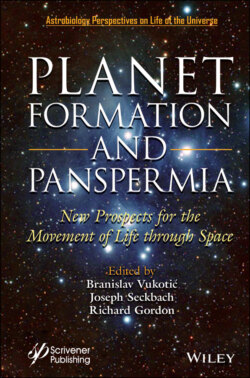Читать книгу Planet Formation and Panspermia - Группа авторов - Страница 25
3.4 Conclusion and Prospects
ОглавлениеWe have discussed a speculative account of the extended continuity thesis and its consequences in the fullness of space and time. Overcoming chronocentrism is difficult but offers several promising directions for further research and for methodological grounding of astrobiology. (This comes in addition to other, and arguably more important roles, the rejection of chronocentrism plays in the domain of environmental ethics, space ethics, or political philosophy.) In affirming the extended continuity thesis as a usable heuristic, we have to avoid pitfalls to which chronocentrism invariably leads in our dynamic, evolutionary universe which is always in change and flux.
The extremely speculative discussion above seems to suggest that directed panspermia becomes more and more important with the passage of cosmic time. Eventually—rather soon on cosmological and evolutionary scales—it will become the main channel of transitioning from non-life to life. This will be true entirely independently of whether directed panspermia ever occurred in our past. Since the habitable future of the universe is so much larger than its past, this means that from a four-dimensional, spatiotemporal point of view, directed panspermia is the main source of life. (“Is” here pertains to the timeless existence, not to the conventional present tense, since human languages have not evolved to enable adequate discussion of the four-dimensional view and other deep metaphysical issues.) Larger here means not only in terms of accessible volume but also in terms of the available design space. Even if past biospheres were limited to Earthlike planets only, future biospheres will not be. Instead, we have strong rationale to expect huge and probably inconceivable diversity of possible habitats. Hence, contrary to our intuitions, it might be the case that advanced life is also, in the fullness of time, a precondition for simple life.12
A common misperception about general theses like the continuity thesis—or indeed Copernicanism or the anthropic principle(s)—is that they contain or imply teleological elements. A superficial reflection is sufficient to establish that it is not the case. If anything, the continuity thesis implies a strongly disteleological view of the major evolutionary transitions: there is no mystical force leading to “jumps” over the low-probability gaps, since in reality, there are no such gaps. However, we shall always keep in mind that it is a useful heuristic and not some mandatory “law”: if it turns out that life and intelligence are very rare in the universe for some reason, we shall have empirical reasons to doubt the validity of the continuity thesis. Clearly, as with any other useful philosophical principle in science, this is an additional motivation, rather than an impediment, for further search and study.
One consequence of the ideas outlined in this chapter is that their future development will likely lead to gradual dissolution of the very concept of habitability, which has emerged as the central concept of astrobiology in the course of the last (roughly) 20 years. If advanced biotechnology enables planting Dyson trees on Kuiper Belt objects by future humans, or if some postbiological civilization successfully seeds atmospheres of gas giants with life, these instances of directed panspermia will obviate the constrains inherent in the very notion of habitability. The situation is further complicated by the reasonable expectation that, if seeding occurred in the sufficiently distant past, it may be very hard or impossible to verify for rather unsophisticated observers such as the present-day or near-future human astrobiologists. (Notice the interesting asymmetry: engaging in directed panspermia in practice seems to be easier than actually verifying whether a biosphere is the product of such intentional activity or an entirely naturalistic evolution in situ. We could launch “soda cans with microbes” toward other planets effectively tomorrow, while to find and prove local origin of another planetary biosphere seems to be a task for another century if not millennium. Whether this asymmetry is a reason to worry about ethical and legal aspects of directed panspermia is an interesting challenge outside of the scope of the present chapter.)
Such a development should not unduly worry us at present for several reasons. First, it is certainly not an immediate prospect. More important, however, is the history-tested conclusion that all theoretical concepts in empirical science have limited lifetime, as our theories are continuously improving and each particular framework is being substituted by an explanatorily better or a more efficient one. Habitability is an immensely useful concept for these early days of astrobiology and it is likely to remain so for decades to come, but we should be aware that it is largely constrained by our anthropocentric and geocentric viewpoint; calls for overcoming the latter can already be heard [3.40]. Not rejecting, but transcending the present-day understanding of habitability will be one of the clearest proofs of progress, and indeed the greatest triumph of future astrobiology.
